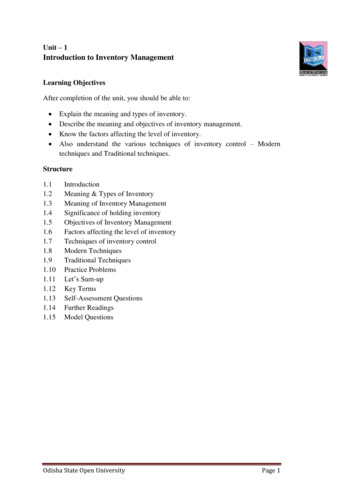
Transcription
Site Inventory FormState Historical Society of Iowa(December 1, 1999)State Inventory No. 70-00179NewSupplementalPart of a district with known boundaries (enter inventory no.) ntributes to a potential district with yet unknown boundariesNational Register Status: (any that apply)ListedDe-listedNHLDOEReview & Compliance No.Non-Extant (enter year)1. Name of Propertyhistoric nameCouch-Carskaddan Houseother names/site numberField Site #: WH-0112. Locationstreet & number411 W. 2nd Streetcity or town MuscatineLegal Description: (If Rural) Township NameTownship No.vicinity, countyMuscatineRange No. Section Quarter of QuarterBlock(s)37Lot(s) Lot 3 & E1/3 Lot 2(If Urban) Subdivision Original Town3. State/Federal Agency Certification [Skip this Section]4. National Park Service Certification [Skip this Section]5. ClassificationCategory of Property (Check only one box) Number of Resources within Propertybuilding(s)If Non-Eligible PropertyIf Eligible Property, enter number of:districtEnter number jectsobjectsTotal2TotalName of related project report or multiple property study (Enter “N/A” if the property is not part of a multiple property examination).TitleHistorical Architectural Data Base NumberA Historical and Architectural Survey of the “West Hill” neighborhood, Muscatine, Iowa6. Function or UseHistoric Functions (Enter categories from instructions)01A01: Domestic / Single residence7. DescriptionArchitectural Classification (Enter categories from instructions)04A: Mid-19th century / Greek Revival70-016Current Functions (Enter categories from instructions)01A01: Domestic / Single residenceMaterials (Enter categories from instructions)foundation03: Brickwalls02: Wood Clapboardroof08A: Asphalt ShingleotherNarrative Description ( SEE CONTINUATION SHEETS, WHICH MUST BE COMPLETED)8. Statement of SignificanceApplicable National Register Criteria (Mark “x” representing your opinion of eligibility after applying relevant National Register criteria)YesNoMore Research RecommendedAProperty is associated with significant events.YesNoMore Research RecommendedBProperty is associated with the lives of significant persons.YesNoMore Research RecommendedCProperty has distinctive architectural characteristics.YesNoMore Research RecommendedDProperty yields significant information in archaeology or history.
County MuscatineCityMuscatineAddress 411 W. 2nd StSite NumberDistrict Number70-0017970-01005Criteria ConsiderationsA Owned by a religious institution or usedfor religious purposes.B Removed from its original location.C A birthplace or grave.D A cemeteryE A reconstructed building, object, or structure.F A commemorative property.G Less than 50 years of age or achieved significance within the past50 years.Areas of Significance (Enter categories from instructions)Significant DatesConstruction date02: Architecture1846check if circa or estimated dateOther dates31 - Other: Neighborhood DevelopmentSignificant PersonArchitect/Builder(Complete if National Register Criterion B is marked above)ArchitectJerome CarskaddanBuilderSEE CONTINUATION SHEETS, WHICH MUST BE COMPLETED)Narrative Statement of Significance (9. Major Bibliographical ReferencesBibliographySee continuation sheet for citations of the books, articles, and other sources used in preparing this form10. Geographic DataUTM References 24See continuation sheet for additional UTM references or comments11. Form Prepared Byname/titleJay Brady, Chair(R.L. McCarley, consultant)organization Muscatine Historic Preservation Commissiondatestreet & numbertelephonecity or town215 SycamoreMuscatinestateNovember 30, 2005IA563-264-1550zip code52761ADDITIONAL DOCUMENTATION (Submit the following items with the completed form)FOR ALL PROPERTIES1.2.3.Map: showing the property’s location in a town/city or township.Site plan: showing position of buildings and structures on the site in relation to public road(s).Photographs: representative black and white photos. If the photos are taken as part of a survey for which the Society is to becurator of the negatives or color slides, a photo/catalog sheet needs to be included with the negatives/slides and the followingneeds to be provided below on this particular inventory site:Roll/slide sheet #Frame/slot #Date TakenRoll/slide sheet #Frame/slot #Date TakenFrame/slot #Date TakenRoll/slide sheet #See continuation sheet or attached photo & slide catalog sheet for list of photo roll or slide entries.Photos/illustrations without negatives are also in this site inventory file.FOR CERTAIN KINDS OF PROPERTIES, INCLUDE THE FOLLOWING AS WELL1.2.Farmstead & District: (List of structures and buildings, known or estimated year built, and contributing or non-contributing status)Barn:a. A sketch of the frame/truss configuration in the form of drawing a typical middle bent of the barn.b. A photograph of the loft showing the frame configuration along one side.c. A sketch floor plan of the interior space arrangements along with the barn’s exterior dimensions in feet.State Historic Preservation Office (SHPO) Use Only Below This LineConcur with above survey opinion on National Register eligibility:YesNoThis is a locally designated property or part of a locally designated district.More Research RecommendedComments:Evaluated by (name/title):Date:
Iowa Department of Cultural AffairsState Historical Society of IowaIowa Site Inventory FormContinuation SheetSite Number 70-00179Related District Number70-01005Page 3Couch-Carskaddan HouseName of PropertyMuscatineCounty411 W. 2nd StreetAddressMuscatineCity7. Narrative DescriptionThis c.1846 Greek Revival house follows the classical format of a two-story, three-bay, symmetrical,central passage house. The house sits on a brick foundation with interior faces plastered. The walls areframe, clad in wood clapboard siding. The side gable roof is clad in asphalt shingles. The house hasseveral features characteristic of the style, including a full width two-story porch, symmetrical façade, andentries with sidelights and transoms. The projecting section on the west side and rear two-story sectionare depicted on the earliest Sanborn map in 1883.The front (south) elevation consists of the two-story recessed front porch running the full width of theoriginal house. The porch features simple Doric columns on both stories, with a later turned railing onthe second story. The center section of the rail has been replaced with a rail section that utilizes plainrectangular wood elements. This section of rail was replaced between 1976 and 2005 based onphotographs from the 1977 Historic Architecture of Muscatine. The center single-door entry has multilight sidelights and transom in a wood frame with small brackets along the pediment. These brackets,like those on the house, are likely a 19th century modification. The entry door is non-historic mahoganywood door. The older French-style door with multiple window panes has been removed and is beingrestored for re-installation. The first story windows have single-over-single-light double-hung sashes witha stained glass transom, likely a late 19th century modification. The windows feature a bracketed lintel.The second story features a center single-door entry with sidelight and transom that opens onto thesecond story of the porch. The door is a fifteen light door. The second-story windows have six-oversingle-light double-hung sashes with bracketed lintels. The eave along the edge of the porch is a simplebox beam with paired brackets at each column. The brackets have downward turned finials. The southelevation of the one story that remains from a c.1875 two-story addition that projects from the west sideof the house features an eight-light center window with adjoining four-light sidelights. A bracketed lintelspans the entire unit similar to those on the original house. The addition’s roof is flat roof with parapet.A c. 1891 photograph of the house shows the house remarkably like the present with the followingexceptions. The windows all have wood side shutters. The west side addition is two-story with an endgable roof facing to the west, rather than the current one story. The house brackets, columns andwindows are generally all similar to the present. A decorative iron fence runs the length of the propertyalong the sidewalk. Two interior end brick chimneys with decorative tops were also on the house at thistime (Semi-Centennial Edition of the Journal 1891: 67). A c.1901 photograph of the house gives a betterview of the two-story west addition and corner alcove. The single story alcove has a tall, slender fourlight window facing the front and two tall, slender four-light windows facing west. The front of theaddition’s first floor has a tall slender four light window with a slender two-light sidelights on each side.The window has a protruding flat window cornice. The second story windows are four light windows.The west elevation has no windows in the second story or gable and a windows in the first floor. Adecorative iron fence runs the length of the property (Picturesque Muscatine c.1901: 589).
Iowa Department of Cultural AffairsState Historical Society of IowaIowa Site Inventory FormContinuation SheetSite Number 70-00179Related District Number70-01005Page 4Couch-Carskaddan HouseName of PropertyMuscatineCounty411 W. 2nd StreetAddressMuscatineCityThe east elevation of the main house is divided into two bays by the slightly offset center brick chimneythat pierces the eave in the gable end. A six-over-single-light double-hung window is located on eachside of the chimney in the second story and a single-over-single-light double-hung window is located oneach side of the chimney in the first story. The windows have bracketed lintels. A non-original brickchimney runs the full height of the house along the south edge of the center bay. The gable eaves haveheavy paired brackets with downturned finials at the outside eave edge, likely added in the 19th centuryafter the original construction. The back portion of the house has a lower sloped roof to the back over atwo story portion of the house. A six-over-single-light double-hung window is located in the second storyand a four window set is located in the first story. The four windows are eight light windows. The eastelevation of the projecting two story gable end portion of the house has a six-over-single-light doublehung window in the second story and a small single-over-single-light double-hung window in the firststory.The west elevation has the end gable of the main house with the projecting historic first story additionwith a flat roof and a rear section with sloped roof set back from the main portion of the addition. TheSanborn maps show it as the same height as the main house through 1919, but the 1928 Sanborn mapshows a one-story side addition. The west elevation of the rear two story ell of the main house is alsovisible. The one story addition has three six-over-six-light double-hung windows without window hoods.A single-over-single-light double-hung window with bracketed lintel is located between the house frontand the one story addition. The rear sloped portion of the one story addition has two six-over-six-lightdouble-hung windows without window hoods. The second story of the main house has two six-oversingle-light double-hung windows with bracketed lintels. The eaves of the gable have heavy pairedbrackets with downturned finials at the outside eave edge, also likely added in the 19th century after theoriginal construction. The west elevation of the second story rear ell has smaller six-over-single-lightdouble-hung window with bracketed lintel.The rear ell, which is depicted on the 1883 Sanborn map, is two story section with a lower and lesssloped roof than the main house. It is offset to the west with a projecting end-gable, forming an ell withthe main house. The first story of the east bay of the main house contains a slightly off-center twoFrench-style door set with ten lights per door (two wide, five high). The second story of the east baycontains a paired six-over-six-light double-hung windows set in a common frame with wood columnseparation. The projecting end-gable middle section of the rear contains a half-glass, single-light wooddoor entry in the east portion of the section with three wood panels in the lower part of the door and awood door lintel. The west portion of the section is a French-style door with two adjoining windows. Thedoors and windows are three by five lights. The second story of the middle section contains a threewindow set with the middle window being a six-over-six light double-hung window and the window oneach side being a four-over-four light double-hung window. The west portion of the rear elevation hastwo six-over-six-light double-hung windows set in the projecting single story sloped portion of the westaddition and a wood panel door entry set in the flat roof portion of the west addition. The door entry hasa canopy roof over the stoop supported by large wood brackets.
Iowa Department of Cultural AffairsState Historical Society of IowaIowa Site Inventory FormContinuation SheetSite Number 70-00179Related District Number70-01005Page 5Couch-Carskaddan HouseName of PropertyMuscatineCounty411 W. 2nd StreetAddressMuscatineCityThe garage is a frame hip-roof building with vertical wood siding. It has a non-original overhead metalgarage door set in its east elevation. This may be the same garage that shows up on the 1928 SanbornMap.The house sits up on the hill above the street and has a concrete sidewalk running along the street atstreet level. A flight of concrete steps leads up to the house level from the street level. A low(approximately 8 course) older brick wall fronts the porch level and contains shrub plantings. A stonecarriage step is at the curb and has carved word “Carskaddan”. The rear yard is fenced with acombination of vertical wood plank fence and concrete block at the garage.8. Narrative Statement of SignificanceThe Couch-Carskaddan House appears to be individually eligible for the National Register of HistoricPlaces under Criterion B and C and is a strong contributing building in a potential “West Hill”neighborhood historic district.The home appears to be individually significant under Criteria B for its association with two prominentand important Muscatine citizens - Moses Couch and Jerome D. Carskaddan. It was constructed by oneof the early pioneers of Muscatine, Moses Couch, who contributed to civic life in Muscatine by serving asrecorder, treasurer, probate judge, starting the Masonic Lodge in Muscatine, and serving theEpiscopalian Church. The home was subsequently occupied and modified by Jerome D. Carskaddan, aprominent attorney and businessman who was one of the leading attorneys of eastern Iowa, served asjudge, was involved in banking, and served as president of the Von Nostrand Saddlery Company. Hewas also writer of the platform for the first Republican party convention held in the county which was alsoperhaps the first convention in the state. Lastly, the house was home to Jerome Bishop, son of WilliamF. Bishop who was associated with several pearl button interests in Muscatine. William was one of fourfounders of the Iowa Pearl Button Company in 1916, and Jerome was also involved in the business. Helater served as president from 1936 to 1945. However, though a prominent citizen, it does not appearthat he had any significant impacts on the history of Muscatine. The home’s Greek Revival styling with asouthern influenced two-story recessed front porch running the full width of the original house and airyFrench style multiple pane doors and windows is unique to the West Hill area in Muscatine. This fineexample appears individually eligible under Criteria C. Thus, the Couch-Carskaddan House appears tobe individually eligible for the National Register of Historic Places under Criterion B and C.The house has strong integrity from the 19th century. The west two-story addition was likely an additionmade in the mid-to late 19th Century. The house was altered between 1919 and 1928 by removal of aone-story porch on the west side of the rear ell, a one-story rear section in the corner of the ell and mainhouse, the one-story alcove on the west side of the house in front of the west side two-story addition.This west side addition went from two stories to one story. A number of outbuildings were alsodemolished, including what may have been a summer kitchen, a two-story carriage house, and aattached one-story building. The rear portion of the house has been modified since 1946 by a two story
Iowa Department of Cultural AffairsState Historical Society of IowaIowa Site Inventory FormContinuation SheetSite Number 70-00179Related District Number70-01005Page 6Couch-Carskaddan HouseName of PropertyMuscatineCounty411 W. 2nd StreetAddressMuscatineCityrear addition in the east bay and a single story addition to the west addition. The additions have beendone in the context of the original house and windows and styling are consistent with the original house.The house is currently under renovation with owners appearing to be replacing and restoring consistentwith acceptable methods. Modifications have been made impacted the integrity from its original 1846period. The house currently retains good integrity from the late 19th Century and the early 20th Centurywhen Jerome D. Carskaddan was residing here. In addition, the historic modifications between 1919and 1928 were made by his descendent, Jerome Bishop, who has significant ties to the button industry.The late 20th Century modifications have been not destroyed the home’s integrity.The Couch-Carskaddan House does appear to be a strong contributing building in a potential “West Hill”neighborhood historic district due to its association with leading civic and business leaders and the pearlbutton industry. Its fine architecture with good integrity contributes to the overall “West Hill”neighborhood.Moses Couch, who arrived in Muscatine in 1836. A purchase record for the property could not beidentified, but local history states that he built this house around 1846. He occupied it for about twentyyears before selling to Jerome Carskaddan in 1865 (Carlson 1997: 80-81). According to his 1889biography, Mr. Couch was “the first person to ornament that part of the city now known as the "Hill" witha fine residence. At that time he had to clear off the brush before he could erect his house” (Portrait andBiographical Album, 1889: 368). Moses Couch, was one of the first hundred residents of the community(Carlson 1997: 80-81). He first lived in a frame house about where the express office now stands, wheremany of the early settlers first stopped (Carlson 1997: 80-81). He later built another home at 707 W. 3rdStreet, where he died in 1879 (Carlson 1997: 80-81). His occupation was painting and glazing, “which hepursued quietly and in the even tenor of his way for many years, acquiring such a competence that withcare and economy it served him as a support when he was obliged to quit active duties of life” (Obituary,1879). Moses Couch was born in Reading, Conn., March 26, 1803. He married Mary A. Plum atMiddletown, Connecticut on January 17, 1830 and moved to moved to southern Illinois. They had anadopted son, Edward, who served with honor in the Civil War. In the original records of Bloomington, asan abstract of the first election, held at the house of R. C. Kinney on May 6, 1839, shows that MosesCouch was elected Recorder, receiving twenty-nine of the thirty-nine votes polled. Subsequently he wasappointed City Treasurer. He was also elected to the office of Probate Judge. He was one of theorganizers of the first Masonic Lodge here, in 1841, and from 1863 to 1865 he was a vestryman of TrinityEpiscopal Church (Carlson 1997: 80-81, Portrait and Biographical Album, 1889: 368). Moses Couchdied on Sept. 23, 1879.On November 13, 1865, Jerome D. Carkskaddan purchased the house from Moses Couch (Lots Book 1:359). He lived here with his wife until he died in 1912. In 1866 Jerome D. Carskaddan was living on thenorth side of 2nd, 2 W of Linn, and practicing law at Richman and Carskaddan according to the citydirectory. Jerome Carskaddan was born on November 6, 1829 in Seneca county, New York. Hegraduated from Hamilton College, of Clinton, New York, in 1851. He was admitted to the New York barin 1853 and came west to Muscatine, Iowa. On the May 1, 1854, Jerome married Miss Marilla Brown,who was born in October 1832 in New York. In January 1854, Jerome Carskadden purchased the
Iowa Department of Cultural AffairsState Historical Society of IowaIowa Site Inventory FormContinuation SheetSite Number 70-00179Related District Number70-01005Page 7Couch-Carskaddan HouseName of PropertyMuscatineCounty411 W. 2nd StreetAddressMuscatineCityDemocrat-Inquirer with T. M. Williams, which he edited and published at Muscatine for two years. Heentered upon the practice of law in 1856 as a partner of the late E. H. Thayer for one year. In 1857, Mr.Carskaddan was chosen as prosecuting attorney of Muscatine County, which office he filled for twoterms. He was an elected county judge from 1861 to 1864. Jerome Carskaddan drew up the platform ofthe first republican convention ever held in Muscatine County, which was probably the first countyconvention of the party ever held in the state. He became an advocate of republican principles at thetime the party was organized, his first vote being cast for Fremont and Dayton in 1856 (Richman 1911:20). The 1860 Census lists Jerome Carskadden, 30, attorney, and Marilla, wife, 28 in Muscatine. Heowned 1,000 in real estate. They had a son and daughter: Paul (born April 14, 1861 and died onNovember 27, 1875) and Gertrude, who would marry William F. Bishop, president of the Hawkeye PearlButton Company, of Muscatine (Richman 1911: 20). The 1870s city directories list Jerome Carskaddanat Richman & Carskaddan and residing on the ns 2d west of Linn. The 1880s city directories list him asattorney at law practicing at 112 W. 2nd and residing at 411 W. 2nd.From 1863 to 1908, Jerome Carskadden was central in a series of law offices. From 1863 to 1879, hewas partners with judge De Witt C. Richman as Richman and Carskaddan, this being regarded as one ofthe strongest law firms of eastern Iowa until its dissolution through the election of Mr. Richman to thecircuit bench. From 1879 to September 1, 1896, he was alone in his law practice. From 1896 to 1906,he was in partnership with William D. Burk as Carskaddan and Burk. The 1890s city directories list himas attorney at law practicing at 112 W. 2nd and residing at 411 W. 2nd. This listing continued until the1897-98 city directory which lists him as practicing with Carskaddan & Burk at 133 W. 2nd and residing at411 W. 2nd. The 1900 city directory lists him with wife Marilla at 411 W. 2nd. Jerome was listed at the lawfirm of Carskaddan and Burk and President of Muscatine Savings Bank and President of Van NostrandSaddlery. The 1900 Census lists Jerome Carskaddan, lawyer, age 70, owning and living at 411 W. 2ndwith his wife of 46 years, Marilla, age 61. In 1906, I. S. Pepper joined the firm under the style ofCarskaddan, Burk & Pepper. That firm continued until the death of Mr. Burk in 1908, since which time thefirm has been Carskaddan & Pepper. The City Directories from 1907 through 1911 list Jerome atCarskaddan Burk & Pepper, President of Van Nostrand and First Trust & Savings Bank. He was livingwith wife Marilla at 411 W. 2nd. Mr. Carskaddan and his partners have represented the Chicago, RockIsland & Pacific Railway Company in Muscatine County since 1863 (Richman 1911: 20).In addition to his law practice, Jerome Carskadden was also active in other community endeavors. Hewas president of the Muscatine Savings Bank, now the First Trust & Savings Bank for a number of years.He was also at one time president of the Van Nostrand Saddlery Company in addition to having beenconnected with several other local enterprises “which profit by his keen business discernment andpowers of organization” (Obituary, 1912). Unpretentious in bearing, cordial and genial in manner, JudgeCarskaddan is nevertheless recognized as one of the eminent members of the Iowa bar, whoseprominence, however, is none the less the result of an irreproachable private life than of professionalability (Richman 1911: 20). Mr. Carskaddan continued to work right up to the day he died. He died onOctober 23, 1912, as a result of drowning in the Mississippi River (Obituary, 1912).
Iowa Department of Cultural AffairsState Historical Society of IowaIowa Site Inventory FormContinuation SheetSite Number 70-00179Related District Number70-01005Page 8Couch-Carskaddan HouseName of PropertyMuscatineCounty411 W. 2nd StreetAddressMuscatineCityMarilla Carskaddan continued to live here until her death on August 13, 1913. Her obituary notes thatshe had resided in Muscatine for more than 50 years and “her death removes from this city a womanwho commanded the highest respect and esteem.” Mrs. Carskaddan was beloved by all who came toknow her. (Obituary 1913). The property was transferred to Marilla’s daughter, Gertrude G. Bishop, onAugust 25, 1913 (Book of Deeds).Roy and Nellie Johnson, mail clerk at the Muscatine and Iowa City Railway, lived here from 1916 through1919 and rented the house from the Gertrude Bishop. The 1920 Census lists 411 W. 2nd as rented byRoy F. Johnson, 45, railroad postal clerk born in Iowa, wife, Netti M., 43, born in Iowa, and a daughter,Ruth, 17 born in Iowa.Though Gertrude Bishop retained ownership, her son Jerome C. Bishop was living here by 1921. Hecontinued to live here through 1961, with Gertrude transferring ownership to Jerome on June 12, 1931(Lots Book 87: 32). Jerome was the son of William F. and Gertrude Bishop (Carskaddan), who marriedon October 15, 1890. William F. Bishop died on May 29, 1931 and Gertrude Bishop died on December20, 1945 (Obituary, 1945). Jerome was born in Muscatine in 1892 (1900 Census). He was a graduate ofCornell University at Ithaca, N.Y. In 1916 he was boarding at his father’s home – W.F. Bishop at 414 W.2nd and working at WF Bishop & Co – Investment Securities and Insurance. In 1919 he is listed with wifeMarie at 609 W. 2nd and working as vice president and treasurer for the Iowa Pearl Button Company.The 1920 Census lists Jerome C. Bishop, no occupation, age 27, living with wife, Marie, age 23, andrenting 609 W. 2nd. From 1921 through 1927 Jerome was listed as secretary of the Iowa Pearl ButtonCompany and residing at 411 W. 2nd Street. From 1929 through 1934 he was listed as secretarytreasurer at the Iowa Pearl Button Company and residing at 411 W. 2nd with his wife Marie. In 1936 he islisted as president of the button company and from 1938 through 1940 he is listed as president-treasurerof the Iowa Pearl Button Company. He continued as proprietor of the Iowa Pearl Button Company until1945 when he sold the company. The Iowa Pearl Button Company continued on through 1959 withCharles R. Hagermann listed as manager in 1946. After this point, he is listed briefly as an engineer atGPC in 1946. He was retired by 1949. Jerome C. Bishop continued to live with his wife Marianna at411 W. 2nd Street until his death on September 8, 1980 at age 88 (Greenwood Cemetery Records).Robert C. Bishop, student was listed at 411 W. 2nd from 1938 through 1943. Mary H. Bishop, studentwas listed at 411 W. 2nd in 1946.Jerome C. Bishop’s obituary notes that he was born January 22, 1892 in Muscatine, graduated fromCornell University with a mechanical engineering degree in 1912 and worked from 1912 to 1916 at AtlasPortland Cement Co. in Hudson, New York. He returned to Muscatine in 1916 and was one of thefounders of the Iowa Pearl Button Company. He served briefly in the Field Artillery in 1918 in World WarI. He was a director of the First National Bank, a director of the First Trust and Savings Bank, served asvestryman and treasurer of the Trinity Episcopal Church and was on the board of trustees for MusserPublic Library for 17 years, represented the owners in the construction of the industrial alcohol plant(1943-1946) and chairman of the Muscatine General Hospital building committee from 1949 to 1954.(Obituary, P.1, 1980).
Iowa Department of Cultural AffairsState Historical Society of IowaIowa Site Inventory FormContinuation SheetSite Number 70-00179Related District Number70-01005Page 9Couch-Carskaddan HouseName of PropertyMuscatineCounty411 W. 2nd StreetAddressMuscatineCity9. Major Bibliographical ReferencesCarlson, JoAnn, ed. Muscatine History Notes, Volume 3. Musser Public Library, 1997, P. 80-81.Census Records, United States Census Bureau, 1860, 1900, 1910, 1920.City Directories, Muscatine. Various publishers, 1856-1959. Available as the Musser Public Library.“Death of Moses Couch”, Obituary, Muscatine Evening Journal, September 23, 1879, P 4.“Death Summons Mrs. W.F. Bishop at Home Here,” Obituary, Muscatine Journal, December 21, 1945, P1.Deed/Abstract Records, Recorder’s Office, Muscatine County Courthouse, Muscatine, Iowa.Greenwood Cemetery Records, http://www.rootsweb.com/ iamuscat/cemetery/b8.htmHistory of Muscatine County, Iowa. Chicago: Western Historical Company, 1879.“Industrialist J.C. Bishop Dies at 88”, Obituary, Muscatine Journal, September 9, 1980, P. 1.“Judge J. Carskaddan Believed Drowned Today”, Obituary, Muscatine Journal, October 23, 1912, P 1.Koch, Augustus. Bird’s-eye View of the City of Muscatine, Muscatine County, Iowa. Koch, 1874. In thecollections of the State Historical Society of Iowa, Iowa City, Iowa.“Mrs. Carskaddan Dies at Home in the City,” Obituary, Muscatine Journal, August 14, 1913, P. 8.Portrait and Biographical Album of Muscatine County, Iowa. Chicago: Acme Publ
Dec 01, 1999 · Muscatine Address 411 W. 2nd St Site Number 70-00179 City . Muscatine . District Number . 70-01005 . Criteria Considerations . A Owned by a religious institution or used . E A reconstructed building, object, or structure. for religious purposes. F A comm











